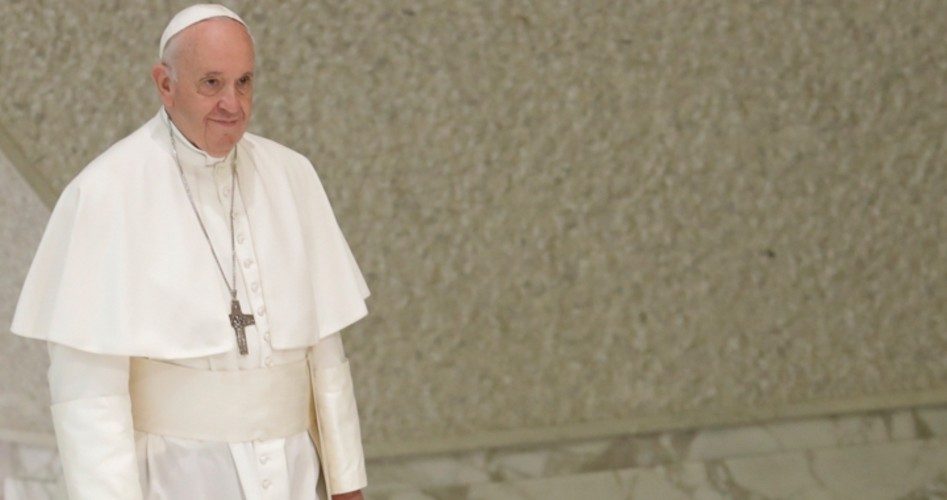
If the bishops asked for married priests, said a close theological advisor to Pope Francis in June, “it’s my judgment that the pope would accept it.” More recently, students of Pope Emeritus Benedict XVI expressed concern at the prospect. This is mild, however, compared to the cardinals who’ve said that they’ll call for the pope’s resignation if the move goes through and observers who warn that it could create a schism.
At issue is the shortage of priests in South America’s Amazon region, which, among 145 other items, will be addressed at a synod of the area’s bishops that Francis will commence at the Vatican on October 6.
As the Daily Mail reports, “The proposal calls for older married men with grown children and a strong standing in the Church — ‘viri probati’ or proven men — to join the priesthood and help fill a gap in sparsely populated communities.”
A good example is the Peruvian village of Wijint. “A three-day boat ride from the nearest town with paved roads,” the Mail also informs, “Wijint is one of 827 native communities in the Vicariate of Yurimaguas, a region nearly the size of Panama ministered by just 25 priests.”
“At least 85% of villages in the region cannot celebrate Mass every week,” the paper continues. Priests also have to be available, of course, for marriages, funerals, baptisms, and confessions.
Understandably, the proposed remedy has sparked intense controversy. The Mail again:
It has been branded heretical by those who believe it takes the Church down a slippery slope towards the abolition of priestly celibacy, which became obligatory in the 12th century….
German Cardinal Gerhard Muller says the document “lacks theological reflection” and puts its faith in “human ideas to save the world” rather than Jesus.
He believes the change could cause a schism so grave that people would leave the Church.
On a recent trip the Pope affirmed he “would rather give his life” than change the celibacy rule, even as he listens to the idea of married priests.
But American Cardinal Raymond Burke is among others who claim they will ask for Francis’ resignation if he goes ahead with the proposal.
Unbeknownst to many, there already are married Catholic priests — as many as 120 in the United States. It’s the result of a change Pope John Paul II made in 1980 that enabled wedded Episcopal priests who wished to convert to Catholicism to continue their ministry. The dispensation was later extended to other Anglican-origin churches.
This was possible because, also unbeknownst to many, priestly celibacy is a tradition and an ideal, not a Catholic Church (CC) dogma. “Dogma” refers to teachings that are incontrovertibly true and are thus unalterable, whereas lesser teachings (such as the prohibition against eating meat on Fridays) can be changed.
Unfortunately, more than this is poorly understood — notably by mainstream media which, while thrilled to report on CC turmoil and perceived liberalization, don’t bother to actually try to understand what they’re reporting on.
A good example is the Daily Beast’s Barbie Latza Nadeau. Snidely addressing the slippery slope concern that coming next might be the allowing of already-ordained priests to marry, she writes that then, “God knows what could happen, maybe even women would be allowed into the priesthood.” This is impossible, however, according to Catholic doctrine. The male-priesthood prescription is an infallible, unchangeable, church teaching, as theologian Mark Lowery, Ph.D. explains here.
Then there is the more basic criticism, the questioning of celibacy itself. It certainly isn’t for everyone, of course (otherwise we’d make the misanthropic, “Humans are a pox on the Earth” types happy — or, more precisely, less unhappy). That said, the Bible clearly references its status as an ideal.
For example, the Apostle Paul says in 1 Corinthians: 8-9, “Now to the unmarried and widows I say this: It is good for them to remain unmarried, as I am. But if they cannot control themselves, let them marry. For it is better to marry than to burn with passion.”
Then, alluding to priestly celibacy, Jesus himself said in Matthew 19:12, “For there are eunuchs, who were born so from their mother’s womb: and there are eunuchs, who were made so by men: and there are eunuchs, who have made themselves eunuchs for the kingdom of heaven. He that can take, let him take it.”
And those who have taken it who are Roman Catholic priests, studies show, are the happiest members of society, are content in their vocations, and are appreciative of celibacy. People in our highly sexualized society have trouble relating to this (it’s like trying to sell a glutton on fasting), but it’s for those with a calling, for “He that can take.”
Also note that far from being unusual, asceticism — including celibacy — has been a feature of many religions for millennia. Hinduism and Buddhism are good examples.
Another argument against priestly celibacy is that it has, supposedly, caused the CC child sex-abuse scandal. Frankly, this assertion is silly.
It proposes one or both of two things. First, there are men with perfectly normal sexual desires who find that they just cannot contain themselves. Instead of satisfying those urges and having affairs with women, however, they instead conclude, “Hey, I’ll get busy with that altar boy over there!” — and open themselves up to scorn, ostracism, hatred, and criminal prosecution, possibly followed by the worst abuse imaginable in prison.
The second claim would be that a celibate priesthood attracts some of the wrong people. The problem with this theory is that, as Hofstra University professor Charol Shakeshaft found after conducting a 2004 federally funded study, the child-sex-abuse problem in government schools is 100 times the magnitude of the church scandal (and is ongoing).
Moreover, while the government-school system is far bigger, note that it enrolls approximately 51 million students annually while Catholic schools enroll approximately two million; it thus has 100 times the abuse problem with only a bit more than 25 times as many students. Also consider that the CC has altar boys (and girls) and had traditionally run orphanages and other entities dealing with children as well. So maybe the solution is a celibate teaching corps.
That won’t happen, of course, but here’s what likely will: Whether or not Amazonian bishops are allowed to ordain some married men, there won’t be a schism because of it and it will not, slippery slope style, lead to an end to the general priestly celibacy rule. You read it here first.
Photo: AP Images



